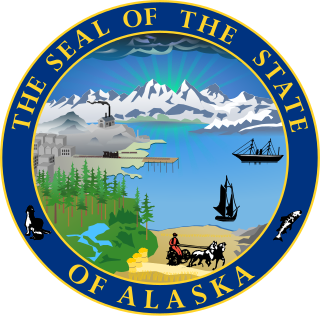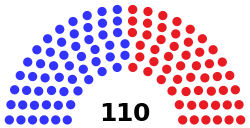
The Alaska Legislature is the state legislature of the U.S. state of Alaska. It is a bicameral institution consisting of the 40-member Alaska House of Representatives and the 20-member Alaska Senate. There are 40 House Districts (1–40) and 20 Senate Districts (A–T). With a total of 60 lawmakers, the Alaska Legislature is the smallest bicameral state legislature in the United States and the second-smallest of all state legislatures. There are no term limits for either chamber. The Alaska Legislature meets in the Alaska State Capitol in Juneau. The current meeting since 2023 is the 33rd Alaska State Legislature. The previous meeting, the 32nd Alaska State Legislature, met from 2021 to 2023.

The Vermont General Assembly is the legislative body of the state of Vermont, in the United States. The Legislature is formally known as the "General Assembly", but the style of "Legislature" is commonly used, including by the body itself. The General Assembly is a bicameral legislature, consisting of the 150-member Vermont House of Representatives and the 30-member Vermont Senate. Members of the House are elected by single and two-member districts. 68 districts choose one member, and 41 choose two, with the term of service being two years. The Senate includes 30 Senators, elected by seven single-member and nine multi-member districts with two or three members each. It is the only state legislative body in the United States in which a third party has had continuous representation and been consecutively elected alongside Democrats and Republicans.

The New Mexico Legislature is the legislative branch of the state government of New Mexico. It is a bicameral body made up of the New Mexico House of Representatives and the New Mexico Senate.

The Hawaii State Legislature is the state legislature of the U.S. state of Hawaii. The state legislature is a bicameral body consisting of a lower house, the Hawaii State House of Representatives, with 51 representatives, and an upper house, the 25-member Hawaii State Senate. There are a total of 76 lawmakers in the legislature, each representing single member districts across the islands. The powers of the legislature are granted under Article III of the Constitution of Hawaii. The legislature convenes at the Hawaii State Capitol building in the state capital of Honolulu, on the island of Oahu.

The Florida Legislature is the legislature of the U.S. state of Florida. It is organized as a bicameral body composed of an upper chamber, the Senate, and a lower chamber, the House of Representatives. Article III, Section 1 of the Florida Constitution, adopted in 1968, defines the role of the legislature and how it is to be constituted. The legislature is composed of 160 state legislators. The primary purpose of the legislature is to enact new laws and amend or repeal existing laws. It meets in the Florida State Capitol building in Tallahassee.

The California State Assembly is the lower house of the California State Legislature, the upper house being the California State Senate. The Assembly convenes, along with the State Senate, at the California State Capitol in Sacramento.

The Florida House of Representatives is the lower house of the Florida Legislature, the state legislature of the U.S. state of Florida, the Florida Senate being the upper house. Article III, Section 1 of the Constitution of Florida, adopted in 1968, defines the role of the Legislature and how it is to be constituted. The House is composed of 120 members, each elected from a single-member district with a population of approximately 180,000 residents. Legislative districts are drawn on the basis of population figures, provided by the federal decennial census. Representatives' terms begin immediately upon their election.

The North Dakota Legislative Assembly is the state legislature of the U.S. state of North Dakota. The Legislative Assembly consists of two chambers, the lower North Dakota House of Representatives, with 94 representatives, and the upper North Dakota Senate, with 47 senators. The state is divided into 47 constituent districts, with two representatives and one senator elected from each district. Due to the Legislative Assembly being a biennial legislature, with the House and Senate sitting for only 80 days in odd-numbered years, a Legislative Council oversees legislative affairs in the interim periods, doing longer-term studies of issues, and drafting legislation for consideration of both houses during the next session.

The Colorado State Senate is the upper house of the Colorado General Assembly, the state legislature of the US state of Colorado. It is composed of 35 members elected from single-member districts, with each district having a population of about 123,000 as of the 2000 census. Senators are elected to four-year terms, and are limited to two consecutive terms in office. Senators who are term-limited become eligible to run again after a one-term respite.

The Michigan Senate is the upper house of the Michigan Legislature. Along with the Michigan House of Representatives, it composes the state legislature, which has powers, roles and duties defined by Article IV of the Michigan Constitution, adopted in 1963. The primary purpose of the Legislature is to enact new laws and amend or repeal existing laws.

The Michigan House of Representatives is the lower house of the Michigan Legislature. There are 110 members, each of whom is elected from constituencies having approximately 77,000 to 91,000 residents, based on population figures from the 2020 U.S. census. Its composition, powers and duties are established in Article IV of the Michigan Constitution.

The Illinois General Assembly is the legislature of the U.S. state of Illinois. It has two chambers, the Illinois House of Representatives and the Illinois Senate. The General Assembly was created by the first state constitution adopted in 1818. As of 2023, the current General Assembly is the 103rd; the term of an assembly lasts two years.

The Tennessee General Assembly (TNGA) is the state legislature of the U.S. state of Tennessee. It is a part-time bicameral legislature consisting of a Senate and a House of Representatives. The Speaker of the Senate carries the additional title and office of Lieutenant Governor of Tennessee. In addition to passing a budget for state government plus other legislation, the General Assembly appoints three state officers specified by the state constitution. It is also the initiating body in any process to amend the state's constitution.

The Mississippi Legislature is the state legislature of the U.S. state of Mississippi. The bicameral Legislature is composed of the lower Mississippi House of Representatives, with 122 members, and the upper Mississippi State Senate, with 52 members. Both representatives and senators serve four-year terms without term limits. The Legislature convenes at the Mississippi State Capitol in Jackson.

The Florida Senate is the upper house of the Florida Legislature, the state legislature of the U.S. state of Florida, the Florida House of Representatives being the lower house. Article III, Section 1 of the Constitution of Florida, adopted in 1968, defines the role of the Legislature and how it is to be constituted. The Senate is composed of 40 members, each elected from a single-member district with a population of approximately 540,000 residents. Legislative districts are drawn on the basis of population figures, provided by the federal decennial census. Senators' terms begin immediately upon their election. The Senate Chamber is located in the State Capitol building.

The Legislature of the State of Oklahoma is the state legislative branch of the U.S. state of Oklahoma. The Oklahoma House of Representatives and Oklahoma Senate are the two houses that make up the bicameral state legislature. There are 101 state representatives, each serving a two-year term, and 48 state senators, who serve four-year terms that are staggered so only half of the Oklahoma Senate districts are eligible in each election cycle. Legislators are elected directly by the people from single member districts of equal population. The Oklahoma Legislature meets annually in the Oklahoma State Capitol in Oklahoma City.

The Utah State Legislature is the state legislature of the U.S. state of Utah. It is a bicameral body, comprising the Utah House of Representatives, with 75 state representatives, and the Utah Senate, with 29 state senators. There are no term limits for either chamber.

The Louisiana State Legislature is the state legislature of the U.S. state of Louisiana. It is a bicameral body, comprising the lower house, the Louisiana House of Representatives with 105 representatives, and the upper house, the Louisiana State Senate with 39 senators. Members of each house are elected from single-member districts of roughly equal populations.

The Kansas House of Representatives is the lower house of the legislature of the U.S. state of Kansas. Composed of 125 state representatives from districts with roughly equal populations of at least 19,000, its members are responsible for crafting and voting on legislation, helping to create a state budget, and legislative oversight over state agencies. Representatives are elected to two-year terms. The Kansas House of Representatives does not have term limits. The legislative session convenes at the Kansas State Capitol in Topeka annually.

The South Dakota State Legislature is the legislative branch of the government of South Dakota. It is a bicameral legislative body, consisting of the South Dakota Senate, which has 35 members, and the South Dakota House of Representatives, which has 70 members. The two houses are similar in most respects; the Senate alone holds the right to confirm gubernatorial appointments to certain offices. In addition, the Senate votes by roll call vote, whereas the larger house uses an electronic voting system.






















